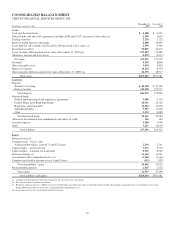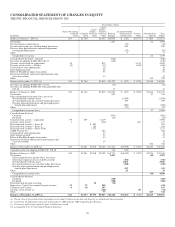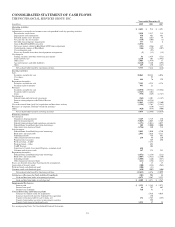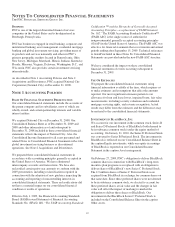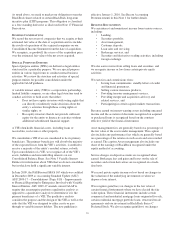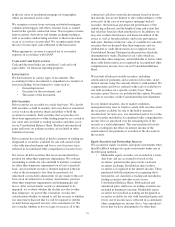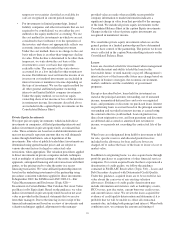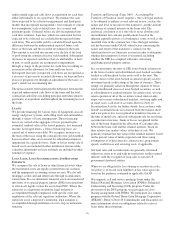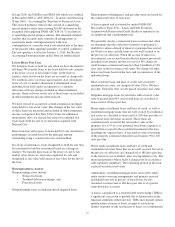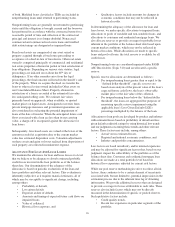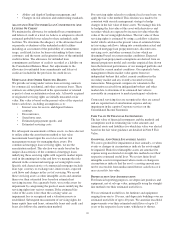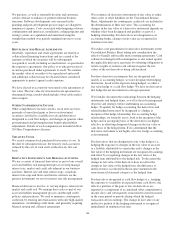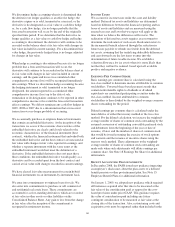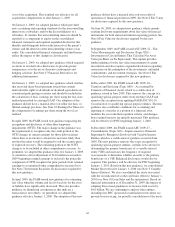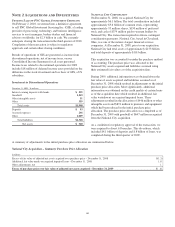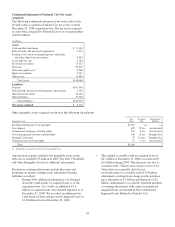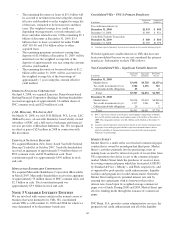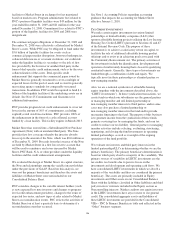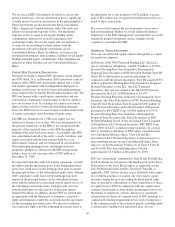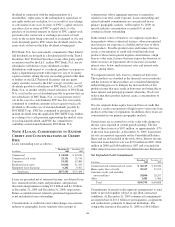PNC Bank 2009 Annual Report Download - page 103
Download and view the complete annual report
Please find page 103 of the 2009 PNC Bank annual report below. You can navigate through the pages in the report by either clicking on the pages listed below, or by using the keyword search tool below to find specific information within the annual report.• Ability and depth of lending management, and
• Changes in risk selection and underwriting standards.
A
LLOWANCE
F
OR
U
NFUNDED
L
OAN
C
OMMITMENTS
A
ND
L
ETTERS
O
F
C
REDIT
We maintain the allowance for unfunded loan commitments
and letters of credit at a level we believe is adequate to absorb
estimated probable losses related to these unfunded credit
facilities. We determine the adequacy of the allowance based
on periodic evaluations of the unfunded credit facilities
including an assessment of the probability of commitment
usage, credit risk factors for loans outstanding to these same
customers, and the terms and expiration dates of the unfunded
credit facilities. The allowance for unfunded loan
commitments and letters of credit is recorded as a liability on
the Consolidated Balance Sheet. Net adjustments to the
allowance for unfunded loan commitments and letters of
credit are included in the provision for credit losses.
M
ORTGAGE
A
ND
O
THER
S
ERVICING
R
IGHTS
We provide servicing under various loan servicing contracts
for commercial, residential, and other consumer loans. These
contracts are either purchased in the open market or retained
as part of a loan securitization or loan sale. All newly acquired
or originated servicing rights are initially measured at fair
value. Fair value is based on the present value of the expected
future cash flows, including assumptions as to:
• Interest rates for escrow and deposit balance
earnings,
• Discount rates,
• Stated note rates,
• Estimated prepayment speeds, and
• Estimated servicing costs.
For subsequent measurements of these assets, we have elected
to utilize either the amortization method or fair value
measurement based upon the asset class and our risk
management strategy for managing these assets. For
commercial mortgage loan servicing rights, we use the
amortization method. This election was made based on the
unique characteristics of the commercial mortgage loans
underlying these servicing rights with regard to market inputs
used in determining fair value and how we manage the risks
inherent in the commercial mortgage servicing rights assets.
Specific risk characteristics of commercial mortgages include
loan type, currency or exchange rate, interest rates, expected
cash flows and changes in the cost of servicing. We record
these servicing assets as other intangible assets and amortize
them over their estimated lives based on estimated net
servicing income. On a quarterly basis, we test the assets for
impairment by categorizing the pools of assets underlying the
servicing rights into various stratum. If the estimated fair
value of the assets is less than the carrying value, an
impairment loss is recognized and a valuation reserve is
established. Subsequent measurement of servicing rights for
home equity lines and loans, automobile loans and credit card
loans also follows the amortization method.
For servicing rights related to residential real estate loans, we
apply the fair value method. This election was made to be
consistent with our risk management strategy to hedge
changes in the fair value of these assets. We manage this risk
by hedging the fair value of this asset with derivatives and
securities which are expected to increase in value when the
value of the servicing right declines. The fair value of these
servicing rights is estimated by using a cash flow valuation
model which calculates the present value of estimated future
net servicing cash flows, taking into consideration actual and
expected mortgage loan prepayment rates, discount rates,
servicing costs, and other economic factors which are
determined based on current market conditions. Expected
mortgage loan prepayment assumptions are derived from an
internal proprietary model and consider empirical data drawn
from the historical performance of our managed portfolio and
adjusted for current market conditions. On a quarterly basis,
management obtains market value quotes from two
independent brokers that reflect current conditions in the
secondary market and any recently executed servicing
transactions. Management compares its valuation to the
information received from independent brokers and other
market data to determine if its estimated fair value is
reasonable in comparison to market participant valuations.
Contractual servicing fees are recognized as they are earned
and are reported net of amortization expense and any
impairment in the caption Corporate services on the
Consolidated Income Statement.
F
AIR
V
ALUE
O
F
F
INANCIAL
I
NSTRUMENTS
The fair value of financial instruments and the methods and
assumptions used in estimating fair value amounts and
financial assets and liabilities for which fair value was elected
based on the fair value guidance are detailed in Note 8 Fair
Value.
G
OODWILL
A
ND
O
THER
I
NTANGIBLE
A
SSETS
We assess goodwill for impairment at least annually, or when
events or changes in circumstances indicate the assets might
be impaired. Finite-lived intangible assets are amortized to
expense using accelerated or straight-line methods over their
respective estimated useful lives. We review finite-lived
intangible assets for impairment when events or changes in
circumstances indicate that the asset’s carrying amount may
not be recoverable from undiscounted future cash flows or it
may exceed its fair value.
D
EPRECIATION
A
ND
A
MORTIZATION
For financial reporting purposes, we depreciate premises and
equipment, net of salvage value, principally using the straight-
line method over their estimated useful lives.
We use estimated useful lives for furniture and equipment
ranging from one to 10 years, and depreciate buildings over an
estimated useful life of up to 40 years. We amortize leasehold
improvements over their estimated useful lives of up to 15
years or the respective lease terms, whichever is shorter.
99


